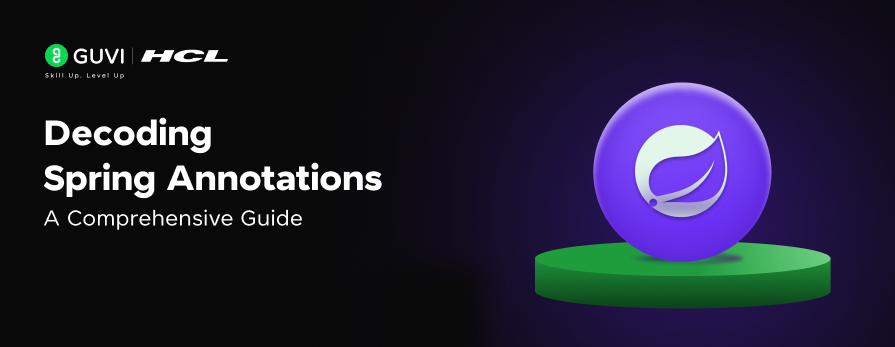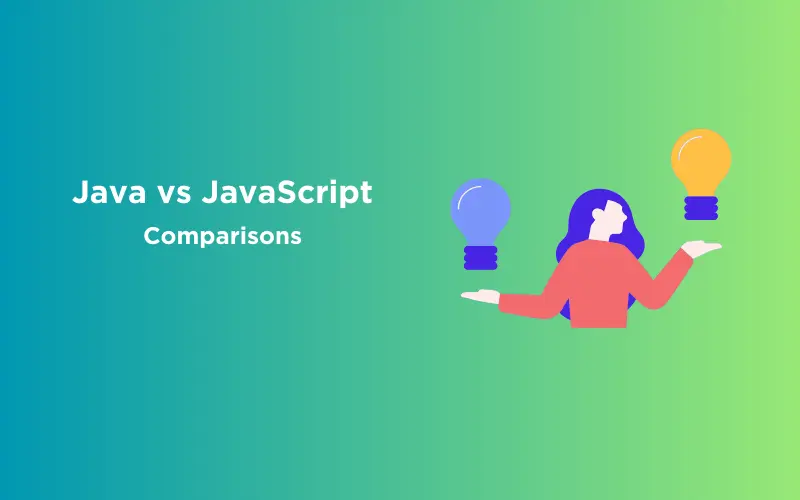
Important Spring Annotations for Efficient Dependency Management and Configuration
Sep 03, 2025 4 Min Read 1074 Views
(Last Updated)
Spring Framework simplifies Java development by offering a robust mechanism for managing dependencies and configurations. One of its key features is the use of annotations, which allow developers to define and manage components, inject dependencies, and configure web requests with minimal boilerplate code.
In this blog, we will explore essential Spring annotations like @Component, @Autowired, @Qualifier, @Primary, @SpringBootApplication, @Bean, and many more. These annotations make Spring applications more efficient, scalable, and maintainable.
Table of contents
- @Component Annotation
- @Autowired Annotations
- @Qualifier Annotations
- @Primary Annotations
- @SpringBootApplication
- @Bean and @Configuration Annotations
- @Controller, @Service, and @Repository Annotations
- @Lazy Annotations
- @Scope Annotations
- @Value Annotations
- @PropertySource Annotations
- @ConfigurationProperties Annotations
- @Controller and @ResponseBody
- @RestController Annotations
- @RequestMapping Annotations
- @GetMapping Annotations
- @PostMapping and @RequestMapping
- @PutMapping Annotation
- @DeleteMapping Annotation:
- @PathVariable Annotations
- @RequestParam Annotations
- @EnableAutoConfiguration Annotations
- @ComponentScan Annotations
- Conclusion:
- Frequently Asked Questions
- What is the difference between @Component, @Service, and @Repository?
- When should I use @Autowired and @Qualifier together?
1. @Component Annotation
@Component is a common annotation used to mark a Java class as a Spring-managed component. It indicates that the class should be considered as a candidate for auto-detection and automatic bean creation by Spring‘s component scanning mechanism.
Example:
@Component
public class MyComponent {
// Class implementation
}
2. @Autowired Annotations
@Autowired is used to automatically wire dependencies by Spring’s dependency injection mechanism. It can be applied to fields, constructors, and setter methods, allowing Spring to automatically resolve and inject the required dependencies.
Example:
@Component
public class MyComponent {
private MyDependency myDependency;
@Autowired
public MyComponent(MyDependency myDependency) {
this.myDependency = myDependency;
}
}
3. @Qualifier Annotations
@Qualifier are used in conjunction with @Autowired to specify which bean should be autowired when multiple beans of the same type are available. It helps to resolve ambiguity when multiple beans match the required dependency.
Example:
@Component
public class MyComponent { @Autowired @Qualifier("myBean") private MyInterface myBean;
}
4. @Primary Annotations
@Primary It is used to indicate a primary bean when multiple beans of the same type are available. It specifies that a particular bean should be preferred when autowiring by type.
Example:
@Component @Primary
public class MyPrimaryBean implements MyInterface {
// Class implementation
}
5. @SpringBootApplication
@SpringBootApplication It is a convenience annotation that combines @Configuration, @EnableAutoConfiguration, and @ComponentScan. It is typically placed on the main application class and enables the Spring Boot auto-configuration and component scanning features.
Example:
SpringBootApplication
public class MyApplication {
public static void main(String[] args) { SpringApplication.run(MyApplication.class, args);
}
}
6. @Bean and @Configuration Annotations
@Bean is used to explicitly declare a bean and is typically used within a class annotated with @Configuration. It allows manual configuration and definition of beans when auto-configuration is not sufficient.
Example:
@Configuration
public class MyConfiguration { @Bean
public MyBean myBean() {
return new MyBean();
}
}
Also Read: Spring Boot AI: A Beginner’s Guide [2025]
7. @Controller, @Service, and @Repository Annotations
These annotations are used to categorize Spring-managed components based on their roles in the application. @Controller is used to mark classes as controllers for handling web requests, @Service is used for business logic components, and @Repository It is used for data access components.
Example:
@Controller
public class MyController {
// Class implementation
}
@Service
public class MyService {
// Class implementation
}
@Repository
public class MyRepository {
// Class implementation
}
8. @Lazy Annotations
@Lazy is used to indicate that a bean should be lazily initialized, i.e., the bean will be created only when it is first requested. This helps optimize the application’s startup time.
Example:
@Component @Lazy
public class MyLazyBean {
// Class implementation
}
Explore: Using Resilience4j in Spring Boot: A Comprehensive Guide
9. @Scope Annotations
@Scope is used to define the scope of a Spring bean. It allows you to specify whether a bean should be a singleton (default), prototype, request, session, or a custom scope.
Example:
@Component @Scope("prototype")
public class MyPrototypeBean {
// Class implementation
}
10. @Value Annotations
@Value is used to inject values into fields, constructors, or setter methods. It allows you to specify property values from configuration files or provide literal values directly.
Example:
@Component
public class MyComponent { @Value("${my.property}") private String myProperty;
}
11. @PropertySource Annotations
@PropertySource is used to specify the location of a properties file to be used for configuring
Spring beans. @PropertySources is used to specify multiple @PropertySource annotations.
Example:
@Configuration @PropertySource("classpath:my.properties") public class MyConfiguration {
// Class implementation
}
12. @ConfigurationProperties Annotations
@ConfigurationProperties is used to bind external properties to a Spring bean. It maps properties from a properties file or environment variables to the fields of the annotated class.
Example:
@Component @ConfigurationProperties(prefix = "my") public class MyConfiguration {
private String property1;
private String property2;
// Getters and setters
}
13. @Controller and @ResponseBody
@Controller is used to mark a class as a controller to handle web requests. @ResponseBody is used to indicate that the return value of a method should be serialized directly into the HTTP response body.
Example:
@Controller
public class MyController { @ResponseBody @GetMapping("/hello") public String hello() {
return "Hello, World!";
}
}
14. @RestController Annotations
@RestController is a combination of @Controller and @ResponseBody. It is used to simplify the creation of RESTful web services by automatically serializing the return value of methods into the response body.
Example:
public class MyRestController { @GetMapping("/hello") public String hello() {
return "Hello, World!";
}
}
15. @RequestMapping Annotations
@RequestMapping It is used to map web requests to specific controller methods. It allows you to define the URL path and HTTP methods that should trigger the execution of a particular method.
Example:
@Controller @RequestMapping("/api") public class MyController {
@GetMapping("/hello") public String hello() { return "Hello, World!";
}
16. @GetMapping Annotations
@GetMapping is a shortcut for @RequestMapping(method = RequestMethod.GET). It is used to map GET HTTP requests to specific controller methods.
Example:
@Controller @RequestMapping("/api") public class MyController {
@GetMapping("/hello")
public String hello() {
return "Hello, World!";
}
}
17. @PostMapping and @RequestMapping
@PostMapping is a shortcut for @RequestMapping(method = RequestMethod.POST). It is used to map POST HTTP requests to specific controller methods. @RequestBody is used to bind the request body to a method parameter.
Example:
@RestController @RequestMapping("/api")
public class MyRestController { @PostMapping("/users")
public User createUser(@RequestBody User user) {
// Process the user data
return user;
}
}
18. @PutMapping Annotation
@PutMapping is a shortcut for @RequestMapping(method = RequestMethod.PUT).
Example:
@RestController @RequestMapping("/api")
public class MyRestController { @PutMapping("/users/{id}")
public User updateUser(@PathVariable("id") Long id, @RequestBody User user)
{
// Update the user with the specified ID
return user;
}
}
19. @DeleteMapping Annotation:
@DeleteMapping is a shortcut for @RequestMapping(method = RequestMethod.DELETE).
It is used to map DELETE HTTP requests to specific controller methods.
Example:
@RestController @RequestMapping("/api")
public class MyRestController { @DeleteMapping("/users/{id}")
public void deleteUser(@PathVariable("id") Long id) {
// Delete the user with the specified ID
}
}
20. @PathVariable Annotations
@PathVariable is used to bind a path variable from the request URL to a method parameter. It allows you to access dynamic parts of the URL.
Example:
@RequestMapping("/api")
public class MyRestController { @GetMapping("/users/{id}")
public User getUserById(@PathVariable("id") Long id) {
// Retrieve and return the user with the specified ID
}
}
21. @RequestParam Annotations
@RequestParam are used to bind request parameters to method parameters in a controller method. It allows you to extract query parameters from the request URL.
Example:
@RestController @RequestMapping("/api")
public class MyRestController { @GetMapping("/users")
public List<User> getUsersByRole(@RequestParam("role") String role) {
// Retrieve and return users based on the specified role
}
}
22. @EnableAutoConfiguration Annotations
@EnableAutoConfiguration is used to enable Spring Boot’s auto-configuration feature. It automatically configures the Spring application based on the classpath and dependencies, reducing the need for manual configuration.
Example:
@RestController @RequestMapping("/api")
public class MyRestController { @GetMapping("/users")
public List<User> getUsersByRole(@RequestParam("role") String role) {
// Retrieve and return users based on the specified role
}
}
23. @ComponentScan Annotations
@ComponentScan It is used to enable component scanning in Spring. It specifies the base package(s) to scan for Spring components, such as @Component, @Controller, @Service, and @Repository.
@SpringBootApplication @ComponentScan(basePackages = "com.example") public class MyApplication {
public static void main(String[] args) { SpringApplication.run(MyApplication.class, args);
}
}
These annotations play a crucial role in Spring applications, enabling various features such as component scanning, dependency injection, request mapping, and configuration management.
Unlock your potential as a Java Full-Stack Developer with our comprehensive Java Full-Stack development course! Dive deep into the world of Java, mastering front-end and back-end development to build powerful, dynamic web applications. Gain hands-on experience with essential tools and frameworks like Spring Boot, Hibernate, Angular, and React, all while learning best practices for performance optimization and scalable coding. Start your journey today and become the all-in-one developer every company is searching for!
Conclusion:
Spring annotations streamline development by reducing XML configuration and enabling powerful dependency injection, component scanning, and web request handling. Understanding these annotations helps developers build well-structured, modular, and efficient Spring applications.
Mastering these annotations will enhance your ability to write clean and maintainable Spring code. Keep experimenting and exploring to make the most of Spring’s powerful features!
Frequently Asked Questions
What is the difference between @Component, @Service, and @Repository?
@Component is a general-purpose annotation for marking a class as a Spring-managed component, while @Service is used for business logic layers, and @Repository is intended for data access layers.
When should I use @Autowired and @Qualifier together?
Use @Autowired for automatic dependency injection and @Qualifier when multiple beans of the same type exist, allowing you to specify the exact bean to inject.


































Did you enjoy this article?